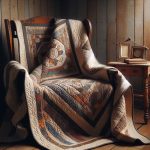Are you curious about quilting with satin fabric? Look no further! In this article, we will explore the characteristics of satin fabric and provide tips and tricks for successfully quilting with it.
Discover how to select the right satin fabric for your project and learn techniques to overcome any challenges that may arise. Whether you’re a beginner or an experienced quilter, this guide will help you create stunning satin quilts with ease.
Table of Contents
Understanding the Characteristics of Satin Fabric for Quilting
If you want to quilt using satin fabric, you should know its unique characteristics and how it behaves during the quilting process.
Satin fabric is known for its smooth and shiny surface, which gives it a luxurious and elegant appearance. It is made from silk or synthetic fibers and has a high thread count, resulting in a soft and lustrous texture. When used in quilting, satin fabric adds a touch of sophistication to your projects.
One of the main characteristics of satin fabric is its drape. It falls beautifully and effortlessly, making it perfect for creating flowing and graceful quilt designs. The smooth surface of satin also allows for easy maneuvering of the fabric under the sewing machine, making quilting a breeze.
Another benefit of quilting with satin fabric is its ability to reflect light. The shiny surface of satin catches and reflects light, adding depth and dimension to your quilts. This can enhance the overall visual appeal and create a stunning effect.
However, it’s important to note that satin fabric can be slippery to work with. Its smooth texture can make it challenging to cut and sew accurately. To overcome this, it is recommended to use sharp scissors or a rotary cutter and pin the fabric securely before sewing.
Understanding the characteristics and benefits of satin fabric for quilting will help you create beautiful and elegant quilts that stand out. So, go ahead and experiment with satin fabric in your quilting projects and enjoy the luxurious touch it adds to your creations.
Selecting the Right Satin Fabric for Your Quilt Project
When selecting satin fabric for your quilt project, it is important to consider the qualities of the fabric. Satin has a smooth and lustrous texture. It comes in a wide range of colors and patterns, allowing you to find the perfect match for your design aesthetic.
Additionally, satin is known for its durability and ease of maintenance. This makes it a practical choice for quilts that will be used and cherished for years to come.
Satin Fabric Qualities
Satin fabric is known for its smooth and glossy texture. It is a popular choice for various projects due to its luxurious appearance. Here are four reasons why satin fabric is favored:
-
Elegance: Satin fabric adds a touch of sophistication and elegance to any garment or home decor item.
-
Comfort: The soft and silky feel of satin fabric against your skin provides a luxurious and comfortable experience.
-
Versatility: Satin fabric can be used for a wide range of applications, including clothing, bedding, and accessories.
-
Durability: Despite its delicate appearance, satin fabric is surprisingly resilient and can withstand regular wear and tear with proper care.
If you’re looking for alternatives to satin fabric, consider options like silk, chiffon, or charmeuse. To care for your satin fabric, hand washing or using a gentle cycle on your washing machine, along with air drying, will help preserve its smooth and glossy texture.
Color and Pattern Options
Consider exploring a variety of color and pattern options when selecting your fabric.
With quilting, the choice of colors and patterns can greatly impact the overall look and feel of your project.
When it comes to color options, you can opt for bold and vibrant hues to create a statement piece or go for more subtle and muted tones for a softer, calming effect.
As for pattern selection, you have endless possibilities. You can choose from traditional patterns like stripes, checks, or florals, or you can get creative with abstract or geometric designs.
The key is to find a combination that reflects your personal style and complements the purpose of your quilt.
Durability and Maintenance
To ensure the durability and easy maintenance of your quilt, it’s important to select a fabric that can withstand regular use and be easily cleaned. When it comes to quilting with satin fabric, keep the following tips in mind:
-
Choose a high-quality satin fabric: Opt for satin that is made from durable fibers to ensure it holds up well over time.
-
Pre-wash the fabric: Before starting your quilt, pre-wash the satin fabric to remove any excess dyes or chemicals that could cause color bleeding or damage.
-
Use a walking foot: When quilting with satin, use a walking foot to prevent puckering or stretching of the fabric, ensuring a smoother finish.
-
Spot clean or hand wash: To maintain the beauty of your satin quilt, spot clean any stains or hand wash it using a gentle detergent. Avoid harsh chemicals or machine washing that can damage the fabric.
Preparing Satin Fabric for Quilting: Tips and Tricks
Before you start quilting with satin fabric, it’s important to prewash and iron it to ensure a smooth and wrinkle-free surface. Preparing satin fabric for sewing is crucial to achieve the best results.
To start, gently hand wash the fabric in lukewarm water with a mild detergent. Avoid using the washing machine as it can cause the fabric to become tangled or damaged. Rinse the satin fabric thoroughly and squeeze out excess water gently, making sure not to wring or twist it.
Lay the fabric flat on a clean towel and roll it up to remove any remaining moisture. Afterward, carefully unfold the fabric and lay it flat on an ironing board. Set your iron to a low heat setting and press the fabric gently, avoiding any harsh movements that could stretch or distort the satin. Be sure to use a pressing cloth or a piece of muslin between the iron and the fabric to prevent any direct heat damage.
By following these steps, you can ensure that your satin fabric is well-prepared for quilting.
When quilting with satin fabric, there are some common mistakes to avoid. First, be mindful of the type of thread you use. Opt for a lightweight thread that matches the color of your fabric to create a seamless look. Heavy threads can create tension and cause the fabric to pucker or distort.
Secondly, take your time when cutting the fabric. Use sharp scissors or a rotary cutter to ensure clean and precise edges. It’s also important to handle the fabric gently to prevent any snags or pulls.
Lastly, be cautious when pressing the fabric during the quilting process. Use a low heat setting and avoid excessive steam to prevent any damage. By being mindful of these common mistakes, you can successfully quilt with satin fabric and achieve beautiful, professional results.
Exploring Quilting Techniques for Satin Fabric
When exploring quilting techniques for satin fabric, it’s essential to experiment with different stitch lengths to achieve the desired effect. Satin fabric has unique qualities that require special attention when quilting.
Here are some techniques to consider:
-
Use a walking foot: This helps to prevent the fabric from shifting and ensures even stitches, maintaining the fabric’s delicate drape.
-
Choose the right needle: A sharp needle with a smaller size works best for satin fabric. It minimizes the risk of snags or pulls and creates clean, precise stitches.
-
Opt for a lighter thread: Using a lighter thread color will make any imperfections less visible. It will also enhance the fabric’s sheen and elegance.
-
Practice on scraps: Before diving into your main project, practice on satin fabric scraps. This will allow you to test different stitch lengths, tensions, and quilting designs without compromising your final piece.
Overcoming Challenges When Quilting With Satin Fabric
Overcoming challenges while quilting with satin can be achieved by utilizing the right techniques and tools. Satin fabric is known for its smooth and delicate texture, which can present unique challenges when it comes to quilting. However, with a few key strategies, you can successfully navigate these obstacles.
One of the main challenges with satin quilting is preventing the fabric from slipping and sliding while you sew. To address this, consider using a walking foot or a Teflon foot on your sewing machine. These specialized feet provide extra traction and help to keep the satin fabric in place as you stitch.
Another challenge is preventing puckering or distortion of the satin fabric. To avoid this, make sure to use a high-quality, sharp needle specifically designed for delicate fabrics. Additionally, using a stabilizer or interfacing can help to add stability and prevent the fabric from stretching or distorting during the quilting process.
Lastly, satin fabric can be prone to fraying, so it’s important to finish the edges properly. Consider using a narrow zigzag stitch or a satin stitch along the raw edges to secure them and minimize fraying.
Finishing Touches: Binding and Embellishments for Satin Quilts
For a polished and eye-catching final touch, consider adding unique embellishments and a carefully selected binding to your satin quilt. These finishing touches not only enhance the overall aesthetic appeal but also provide durability and longevity to your quilt.
Here are four binding techniques and decorative stitching ideas to inspire you:
-
Bias Binding: Create a beautiful and smooth edge by using bias-cut satin fabric for the binding. This technique adds a touch of elegance and ensures a clean finish.
-
Piped Binding: Add a pop of color and dimension by incorporating piping into your quilt’s binding. This decorative detail creates a striking contrast and adds visual interest.
-
Decorative Stitching: Experiment with various decorative stitching patterns to personalize your quilt. From intricate designs to simple motifs, decorative stitching can highlight specific areas or create an overall decorative effect.
-
Beaded Embellishments: Embellish your quilt with delicate beads for a touch of glamour. Whether you choose to scatter them randomly or create intricate patterns, beaded embellishments can elevate your satin quilt to a whole new level of sophistication.
Conclusion
In conclusion, quilting with satin fabric can be a rewarding and unique experience. By understanding the characteristics of satin fabric and selecting the right type for your project, you can create stunning quilts with a luxurious touch.
Preparing satin fabric properly and exploring different quilting techniques will help you achieve the desired results. While there may be some challenges along the way, with patience and practice, you can overcome them.
Finally, adding binding and embellishments will add the finishing touches to your satin quilts, making them truly special.
- How Does Ring Spun Cotton Affect Garment Fit and Shape Retention? - August 13, 2024
- What Are the Challenges in Producing Ring Spun Cotton? - August 13, 2024
- Is Ring Spun Cotton Suitable for Plus-Size Clothing? - August 13, 2024



